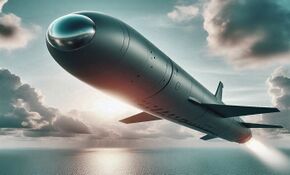ASM-11 Sirena
| ASM-11 Sirena | |
|---|---|
 ASM-11E fired from a AH-9 Sibrona | |
| Type | Anti-Ship Missile (AShM) |
| Place of origin | |
| Service history | |
| In service | 1994-present |
| Used by | |
| Production history | |
| Designer | Navayelle Systems |
| Designed | 1987 |
| Manufacturer | Navayelle Systems |
| Produced | 1988-present |
| Specifications | |
| Weight | 375kg |
Detonation mechanism | Delayed impact fuse |
| Blast yield | 100kg Variable |
Operational range |
|
| Flight altitude | 10-30m above surface |
| Speed | High Subsonic |
Guidance system | Active Radar or TV-Guided |
The ASM-11 Sirena is an Inyurstan subsonic anti-ship missile. Known for its light weight and large number of versatile variants, the Sirena is one of the most widely produced and exported missiles in the Inyurstan arsenal.
Overview
With a baseline weight of 375kg, and a base length of 3.6m, the ASM-11 can be carried by both helicopters and fixed wing aviation. Later models were adapted to launch from trucks and surface ships.
A wide variety of guidance options are available, though in most cases an active radar guidance is used. During the Lolloh-Ruol Wars, TV-guidance grew in popularity among naval aviation crews for several reasons, including: 1) better discretion against passive decoys and maritime clutter, 2) the ability to manually direct the missile onto a specific section of the ship.
Variants
ASM-11
ASM-11PE+ (Block II)
The Block II standard was developed based on lessons learned in the Lolloh-Ruol Wars, where certain vessels such as the Lollohian Stallion-Class Battlecruiser utilized high-powered, tall-mast radar to push the envelope of detection against low-altitude targets. Because of this, pilots were either having to, if only briefly, enter radar "sight" of enemy warships or launch their Sirens at the absolute edge of their combat radius. Simple solutions included the addition of a jettisionable rocket booster, addition of "glide wings" to lift and keep the missile at or above altitude between the energy of the rocket launch wearing off and the main engine thrust kicking in, and high-boron propellant to improve maneuver capability during terminal maneuvers. Most of the "Block II" models were thus given the designation "PE" for "Portêo Extendé" (Extended Range) because of these inclusions. Block II seekers are also the first to offer "reattack" capabilities, where a missile that missed the target executes a U-turn and circles back to reengage the target, provided enough remaining velocity and fuel.
ASM-11PE: 2008 Production model including the range-extending Block II upgrades.
ASM-11PE2: The ASM-11E2 utilizes a dual radar & IR homing seeker for terminal guidance. The combination is believed to improve targeting capabilities when the enemy is using decoys. By using a negative equation, where only targets that produce both a "near-profile" radar return AND a "near-profile" IR signature, the missile can discriminate against certain kinds of softkill measures. When executing a reattack, the seeker on the PE2 variant is also designed to the account for the combination of radar & IR signature which caused it to miss the first time and select for a different combination on the second impact attempt.
ASM-11E Short Range Improved Performance (SRIP): Known by its English acronym "The SRIP", the ASM-11E is a variant intended to be carried by helicopters. Because helicopters were generally engaging targets which lacked the long-range radars of capital ships (such as corvettes or transports), the rocket booster was considered unnecessary weight and its harder launches resulting in more wear-and-tear. However, because such ships (especially corvettes and missile boats) were equally - if not more - reliant on softkill measures and maneuvering, the seeker improvements were considered a necessary upgrade.
ASM-11PE3 Êconoméa Effícianté: Dubbed the "Triple E", the ASM-11E3 is a mass-production and export model. To save costs, multiple commercial-off-the-shelf parts are used, and a more simplistic GPS/TIMU flight computer is used. The active radar warhead only kicks in within terminal range, to save battery life and cost, for homing guidance.
ASM-11M+ (Block III)
The "Block III" standard includes multiple "energy saving" features into production models. Such features include improved glide wings, improved jettison-able rocket booster and delayed-sea skimming modes. By delaying the sea skimming profile, the missile can act as a glide weapon at more medium altitudes and slowly descend towards the surface prior to following a less-efficient sea skimming profile below enemy radar.
ASM-11M: The standard "Block III" model, the ASM-11M uses an active radar homing warhead along with GPS/TIMU for navigation, and then assistance from an IR homing warhead for terminal guidance.
ASM-11M2: Fitted with a multisensor autonomous-targeting seeker, similar to that on the ASM-13 Scylla, the ASM-11M2 is currently the most capable variant of the Sirena family. Able to specifically target a subsection of an individual ship, the seeker can also "avoid" clutter, non-target, and high-emissions "threat" points as it navigates to the target. Because of this warhead type, the ASM-11M2 can function when the "kill chain" has been lost.
SSM-11
ASM-11PE2 Barracuda
Main Article: ASM-11PE2 Barracuda
The Barracuda is a land-attack missile developed from the ASM-11E2 designed to engage strategic and operational targets.